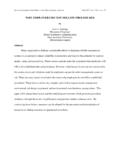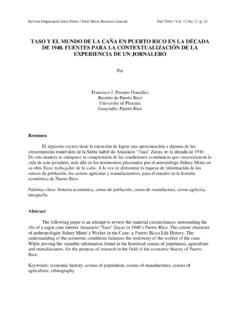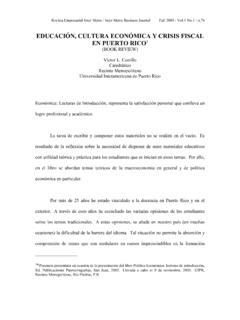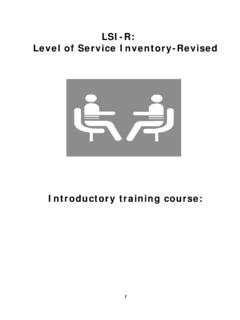Transcription of International Accounting Firms: The Big Four Evolution
1 Revista Empresarial Inter Metro / Inter Metro Business Journal Fall 2014 / Vol. 10 No. 2 / p. 1. International Accounting FIRMS: THE big four Evolution . By Norman E. Cruz Faculty Puerto Rico Campus University of Phoenix Abstract Author reviews academic literature and discusses about multinational enterprises (MNEs) in the service sector that decided to improve their businesses by forming strategic alliances. It is covered specifically the alliances of International Accounting firms (IAFs) to establish the following objectives: review major reasons for companies to create strategic alliances and their preferred modalities, and verify the IAFs business performance based on their revenues obtained on 2004 and 2014 before and after the most recent worldwide economic recession. Keywords: International Accounting Firms, Strategic Alliances, Economic Cycles, SOX. Introduction Morse (1992) defines strategic alliances as arrangements between companies that assist in the penetration of a new market by one of the companies.
2 Examples of alliances are: the licensing of one company by another to manufacture and sell its product or provide its service;. the sub-contracting of one company by another to produce its product or provide its service; the marketing of one company's products or services by another company or by both companies jointly; the distribution of one company's products by another company's distribution network;. the representation by an agent for the sales or services of a company; the transfer of technological information from one company to another; and the importation into a country of a company's product by an importing company located therein. Revista Empresarial Inter Metro / Inter Metro Business Journal Fall 2014 / Vol. 10 No. 2 / p. 2. In recent decades, many companies decide to re-structure their organizations by performing alliances, among other options in order to increase their power or attractiveness no matter from which industries are and to which markets serve (Bushko & Raynor 2000, Segil 2000, Stahl 1995, Roberts & Liu 2001).
3 These corporate re-organization strategies had their peaks in United States by 1980s and in the rest of the world by 1990s, when economy showed growth. Due to their nature, certain industries need to respond more quickly than other ones to establish new strategies and take advantage of their competitors. For instance, the IAFs are in an industry where services offered are in constant demand and are interested by competitors with huge resources , capital, people, and technology. This situation justifies why sometimes companies decide to modify their organizations by creating alliances in a speedy fashion. Most frameworks used to aid managerial decision-making in multinationals are largely based upon data collected in the manufacturing sector. Much of the recent restructuring occurring in manufacturing MNEs such as downsizing, renewed focus on core business and a growing dissatisfaction with conglomerate operations are consistent with the normative prescriptions of these frameworks.
4 However, in contrast to these trends, the service sector has been characterized by a different pattern of organizational restructuring. This pattern includes continuing internationalization and increasing company size and scope. This suggests that there may also be critical differences in the principles, which guide the strategic management of service companies (Campbell & Verbeke 1997). Strategic Alliances This manifestation of organizational cooperative strategies has been focus of numerous studies in the business literature mainly in the manufacturing sector. Strategic Alliances Revista Empresarial Inter Metro / Inter Metro Business Journal Fall 2014 / Vol. 10 No. 2 / p. 3. comprise companies that remain legally independent and cooperate to achieve a competitive advantage by exchanging or consolidating resources and services (Kogut 1988). Alliances preserve legal independence and even economic autonomy - outside the field of cooperation.
5 The linkage of participating companies may terminate unilaterally (reversible). Strategic alliances whether with competitors, suppliers, vendors, or complementary partners are frequently the most efficient and effective means for achieving immediate access to the capital, talent, distribution channels, or manufacturing capabilities essential for maintaining market leadership (Garai 1999). Alliances are more favorable in the face of high environmental uncertainty and knowledge dispersion because collaborations increase strategic flexibility and rapid learning (Hoffmann & Schaper-Rinkel 2001). The objectives underlying the entry into strategic alliances are due to several motives (Varadarajan 1999), such as: market entry and market position, product or service, product or service market, market structure modification, market entry timing, resource utilization efficiency, resource extension and risk reduction, and skill enhancement.
6 After their respective studies, Freidheim Jr. (1999) and Segil (2000) consider that ingredients for successful alliances are: Know what your company wants in an alliance partner and why have a clear vision and understanding why an alliance is important to achieving it;. Pick your partner for positive reasons set your selection criteria and do not choose a partner because it is the best available;. Ally for the long term go in with the intent that the alliance will last as long as the business opportunity;. Revista Empresarial Inter Metro / Inter Metro Business Journal Fall 2014 / Vol. 10 No. 2 / p. 4. Make the benefits and risks equitable an unhappy partner will get even or get out, thus structure the division of value created so that company will be willing to accept either partner's position;. Assign the best and the brightest assign people to win unwillingness to put top talent into an alliance is a sure signal of the value of the alliance.
7 Ensure the alliance has common objectives understand why your partner wants the alliance and whether its objectives are consistent with your company's objectives;. Communicate invest in the infrastructure that makes it easy to communicate and do business together;. Hope for the best and prepare for the worst take breakup provisions and make it tough to trigger dissolution;. Invest continued support, investment and attention often separate successful alliances from unsuccessful ones;. Master the details alliance leaders do business better than anyone else does; and Cultural compatibility for companies collaborating with foreign businesses, it is critical that they eliminate barriers, such as language differences. Evolution of International Accounting Firms Back in the early 1970s, the Accounting profession was a gentlemanly affair. Auditors were like bankers: conservative, straightforward, and ethical to a fault.
8 Indeed, accountants routinely topped the lists of most-admired professionals. The shift can be traced to 1978, when the American Institute of Certified Public Accountants (AICPA) revoked the veto on advertising and solicitation. The end of that prohibition triggered a land grab in the Accounting industry, and a big push into consulting services (Goff 2004). The pressure that high competition is providing Revista Empresarial Inter Metro / Inter Metro Business Journal Fall 2014 / Vol. 10 No. 2 / p. 5. to the consulting companies make that IAFs be protective with their personnel. According to Ernst & Young, up-to 25% of its former employees comes back to the company, keeping their knowledge and experience out of their competitors. The IAFs, specifically the big four Deloitte Touche Tohmatsu, Ernst & Young, KPMG, and PricewaterhouseCoopers are currently established as limited liability partnerships.
9 Originally, they were oriented to the following main core of services: tax and audit. Throughout the years, these companies started to work in many countries as possible , within Europe, North America, Latin America, Africa, and Asia. This involvement grew out of their desire to follow important clients overseas. As indicated on their annual reports, the IAFs open new offices around the globe by placing human resources , partners, principals, managers, seniors, staff, and administrative personnel from current offices, or by forming alliances with local service companies. Thus, it has been necessary to provide new and innovative services, such as: financial advisory services, and consulting in as many industries as possible. Their clients are in the following business sectors: automotive; energy, utilities and mining; industrial products; pharmaceuticals; retail and consumer; services; banking & capital markets and investment management; insurance.
10 Entertainment and media; communication and technology, among many others. In seeking to serve these clients, a variety of arrangements were developed across and within enterprises. Seven major types of arrangement have been utilized, usually varying according to the relationship between the International company and the local practices (Daniels, Thrift, & Leyshon 1989). These arrangements are identified as: the company operates under its own International name , PricewaterhouseCoopers; a combined name is used where an International company affiliates with a local company; a local name is used where the local Revista Empresarial Inter Metro / Inter Metro Business Journal Fall 2014 / Vol. 10 No. 2 / p. 6. company is totally affiliated with the International company; an association or federation may be relied on to coordinate activity among member companies; correspondents may be used if an International company does not have an office in a particular area and exclusively refers clients to a single local company; on rare occasions, a local company may have multiple affiliations with several International companies; and a final case is when two or more names occur, where an International company practices under two or more national company names.
















